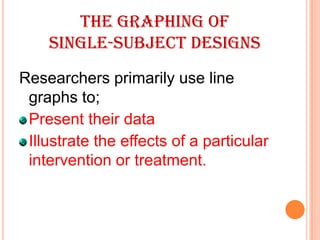Presentation edu 702
- 1. QUANTITATIVE RESEARCH METHODOLOGIES SINGLE-SUBJECT RESEARCH
- 2. ESSENTIAL CHARACTERISTICS ïĒData are collected and analyzed for only one subject at one time. ïĒMost commonly used to study the changes in behavior
- 3. THE GRAPHING OF SINGLE-SUBJECT DESIGNS Researchers primarily use line graphs to; Present their data Illustrate the effects of a particular intervention or treatment.
- 4. THE A-B DESIGN ïĒ Collecting data on the same subject, operating as his or her own control under two conditions or phases. ïĒ First condition (A); pretreatment condition ïĒ Second condition (B); treatment or intervention condition, introduced and maintained for a period of time. ïĒ figure 14.2 A-B Design.jpg
- 5. DISADVANTAGE OF A-B DESIGN ïĒResearcher does not know whether any behavior change occurred because of the treatment.
- 6. THE A-B-A DESIGN ïĒ Sometimes called reversal design ïĒ Researchers simply add another baseline period ïĒ To get stronger evidence for the effectiveness of the intervention ïĒ Reduce threats to internal validity ïĒ figure 14.3 A-B-A Design.jpg
- 7. DISADVANTAGE OF A-B-A DESIGN ïĒItinvolves leaving the subjects in the A condition. ïĒStudiesended without some degree of final improvement.
- 8. THE A-B-A-B DESIGN ïĒ Two baseline periods are combined with two treatment periods. ïĒ Permits the effectiveness of the treatment. ïĒ Avoids leaving subject without an intervention. ïĒ Demonstrate that dependent variable changes as independent variable is applied. ïĒ figure 14.4 A-B-A-B Design.jpg
- 9. DISADVANTAGES OF A-B-A-B DESIGN ïĒThe possibility of data-collector bias ïĒAn instrumentation effect; need for an extensive number of data collections period
- 10. THE B-A-B DESIGN ïĒ Involvesa treatment followed by a baseline by a return to the treatment. ïĒ Appropriate when there is a lack of behavior. ïĒ figure 14.5 B-A-B Design.jpg
- 11. THE A-B-C-B DESIGN ïĒ Further modification of the A-B-A design. ïĒ The intervention is changed to control for any extra attention the subject may have received. ïĒ Contingent(or selective) praise is critical for improved responsiveness. ïĒ figure 14.6 A-B-C-B Design.jpg
- 12. MULTIPLE-BASELINE DESIGNS ïĒ Researcher do more than collect data on one behavior. ïĒ They collect on several behaviors for one subject. ïĒ Researchers systematically apply the treatment at different time for each behavior. ïĒ figure 14.8 Multiple-Baseline Design.jpg ïĒ Treatment is applied to change behaviors accordingly.
- 13. THREATS TO INTERNAL VALIDITY 1. Condition length 2. Number of variables changed when moving from one condition to another. 3. Degree and speed of change. 4. Return to baseline level 5. Independence of behavior 6. Number of baseline
- 14. THINGS TO PONDER ïĒ Whichdo you think is easier to conduct: single subject or group comparison research? Why? ïĒ What sorts of behaviors might require only a few data points to establish a baseline?













